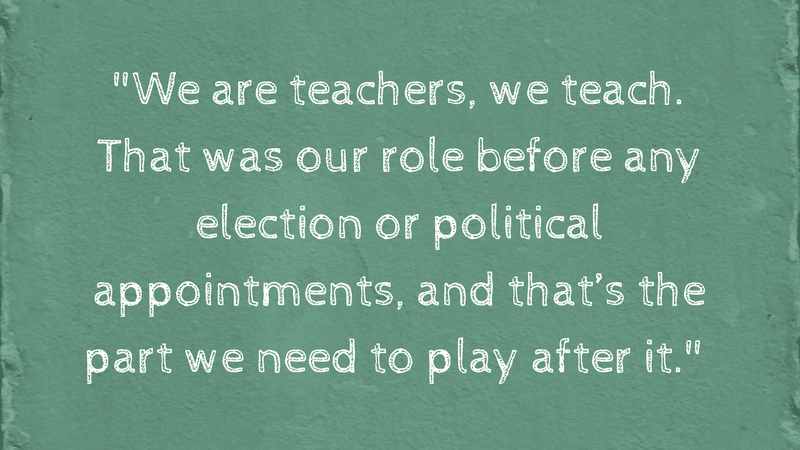If you’re politically aware, you may be feeling a sense of dread, or of helplessness, or of rage, or maybe some sort of schadenfreude. Some are protesting, some are donating, some are relentlessly posting on social media. Me too. The call to action is strong.
But for a teacher—especially an English teacher—the desire to shape young minds needs to come with some restraint and professionalism. Depending on where you teach, sharing political views in the class is tricky at best, alienating at worst. So how do we address current events? We don’t. We are English teachers. We teach stories.
The question of how to respond to current events was posed to me or near me often in the past weeks. From department members, from friends, and even in a message from a mentor. This mentor was someone who found a way to get through to me many years ago, so it made me want to do the same. But how?
It seems counterintuitive but perhaps consistency is the best policy. We are teachers, we teach. That was our role before any election or political appointments, and that’s the part we need to play after it. We need to be there for our students for the whole run—all 180 days—which by the way, is longer than a baseball season but arguably more exciting. It’s not as cathartic as protesting nor is it as glamorous as a defiant speech at an awards ceremony. But it’s what we do, and it can be even more subversive in the long run.

I have to be honest. I initially had the urge to make a change in my curriculum. And perhaps with my AP students I can bring in articles and have lengthy debates with them. In my film class, we can watch science fiction and make the requisite comparison to our own times. But then I thought about three books I teach in my freshmen classes: Night, The House On Mango Street, and American Born Chinese—and I decided to stay the course.
The books are modern, perhaps post-modern, but they’re not necessarily current. Nor are they overtly about political process. Elie Wiesel’s haunting account of his time in a concentration camp is as much a text about personal protest and existential responsibility as it is about the Holocaust itself. Sandra Cisneros paints a poetic yet emotionally antagonistic portrait of one girl’s neighborhood. Gene Luen Yang mixes mythology and teen angst to offer a tale of seeking an identity that may or may not be right in front of us. This graphic novel is perhaps the most cutting-edge of the three.
These are diverse works from diverse eras by a diverse set of writers but what they all have in common are the human experiences that derive as much power from the stories they’re situated in as from the fact that there is something to relate to in each text (beyond that there’s something universally uncomfortable about adolescence). And that is what should be taught. Stories entertain, but stories also unite. Stories demand empathy, sympathy, understanding, and in some cases leaving our comfort zone. We care more about people when we read about them and in turn we care more about each other.

So I say let the text do the heavy lifting, and I promise your students will make the connections. Let them bring up something that seems eerily familiar to what they read in the news—real or fake. Let them feel compassion. Let them write about these basic human issues. Controversy is built into stories. We call it conflict. Let them learn through the experience of reading and being part of a small classroom community. Like every culture before us, we are stories. If we teach kids through stories they will grow up to help to shape our collective story for the better. Not to mention a book will last much longer than a protest sign or an internet meme.
